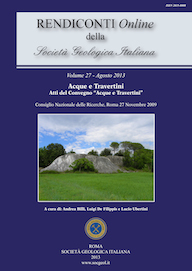
Travertines of central and southern Italy
Bruno D’Argenio (*), Vittoria Ferreri (*) & Erlisiana Anzalone (*)
(*) Consiglio Nazionale delle Ricerche, IAMC, Napoli. E-mail: b.dargenio@iamc.cnr.it
DOI: https://doi.org/10.3301/ROL.2013.16
Volume: 27/2013
Pages: 4-9
Abstract
This is a short presentation of central and southern Italy travertine deposits based on several case histories analyzed in the last decades. Travertines are freshwater carbonate sediments forming in miniature depositional systems and are originated by precipitation from fluvial or spring waters. They display peculiar characteristics, like the ability to modify the morphology of their substrate, and to give rise commonly to “small” sedimentary bodies. Parent water temperature is a key factor in these deposits: high values bring on elevated carbonate precipitation rates and a decrease of abundance, size, and diversity of the eukaryotic organisms colonizing the depositional sites, while the decrease of temperature has an opposite outcome. This allows to distinguish between thermal- and ambient-water travertines (the latter often referred to as calcareous tufa), the transition between these two end-members being often gradual. The space-time evolution of the above sediments tends to modify the original substrate morphology, giving origin to different sedimentary environments (slope, shallow-lake/swamp, rapid/waterfall). Owing to their areal and vertical distribution, Italian travertines build terraced bodies whose upward growth is punctuated by recurrent erosional and/or non depositional discontinuities. The systematic (cyclic?) alternation of periods of calcium carbonate precipitation and starvation intervals suggests allocyclic regulation of climatic origin, even though autocyclic control mechanisms (sometimes including volcanism and/or tectonics) have to be also taken into account locally.
Keywords
Get Full Text